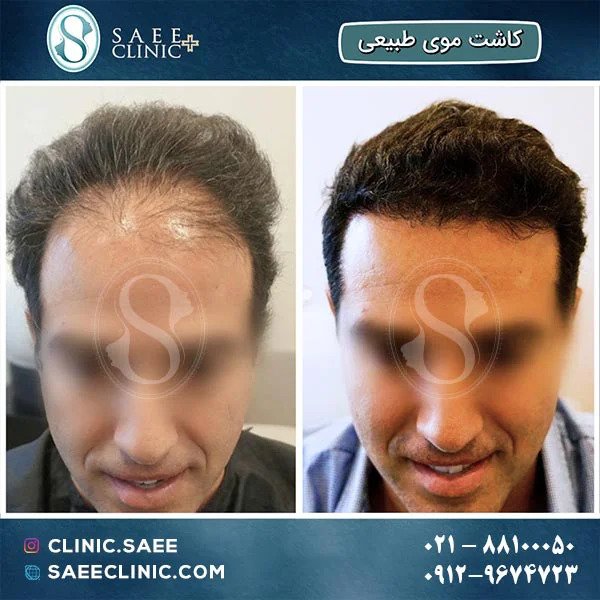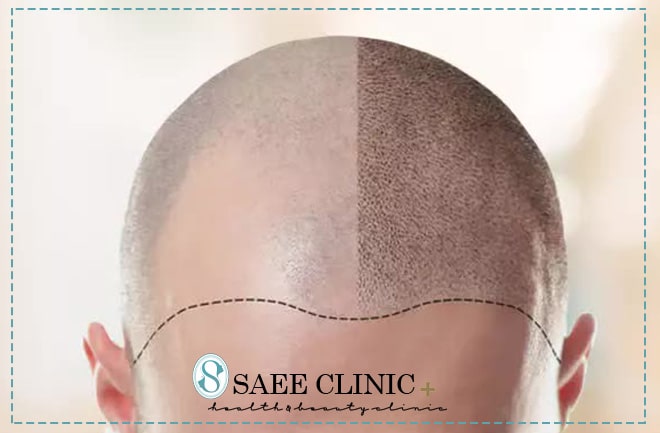FIT hair transplantation is one of the most popular hair transplantation methods in Iran. A less aggressive and effective way that can easily give you a hairy series. Today, we are going to take a practical and accurate look at this method of hair transplantation with the help of the specialist doctor of Saei Clinic. Let me see why the FIT method is so popular, how it is done, what are the advantages and disadvantages, what are the side effects of this method and what are the costs of FIT hair transplantation. If you are going to have a hair transplant, read this article carefully.
FIT hair transplantation
According to the diagnosis of a specialist, hair transplants for different hair loss patterns are possible. Examination of all honored patients who apply for FIT hair transplantation and other hair transplantation methods is a necessity, based on which it will be determined which one can use the hair transplant method of FIT hair transplantation method, FUT hair transplantation or SUT hair transplantation.
The examination will determine if the person’s hair bank has the necessary ability to perform FIT hair transplantation or any of the other methods of hair transplantation. But many people who suffer from hair loss and baldness on the scalp can achieve their natural and normal appearance by using any of the hair transplant methods, including FIT hair transplant.
The reason why the FIT method is so popular in the world
FIT hair transplantation is one of the most popular hair transplantation methods. But why is the FIT method so popular? In this section, we want to take a look at the most important features of the FIT method, and in the following sections of the article, we will examine this method in more detail.
The first reason: definitive treatment of hair loss
Hair transplantation is the only permanent and definitive treatment for hair loss. Of course, there are many ways to prevent hair loss and slow down the process; Such as finasteride and minoxidil, hair mesotherapy, PRP or laser therapy. All of these methods can be effective in reducing hair loss, but they do not cause new hair to grow on your scalp. If you have bald spots on your head, hair transplantation is the only way to compensate for this baldness.
All hair transplants, including the FIT method, can treat your hair loss. What happens in hair transplants is that the hair-forming structures in the body, called follicles, are transferred from the hair bank to the bald areas. The follicles that are in the new place make new hair and these hairs grow. Most importantly, these new hairs are resistant to hair loss. So we expect them to have lasting results for you.
The second reason: less aggressive and less painful
Part of the popularity of the FIT method is that it is one of the most effective and painless methods; A minimally invasive procedure, without bleeding, without the need for stitches, and with a simple recovery period. The FIT method is also called non-surgical hair transplantation. Of course, hair transplantation with this method is still considered a surgery, but it is so invasive that it has received this title.

Steps of hair transplantation by FIT method
The steps of FIT hair transplantation include extracting the follicles from the hair bank, preparing the grafts and finally implanting the grafts in the receiving area. But there are steps before and after hair transplant that we should mention.
Before hair transplantation
Advice:
In the first place, it should be seen whether hair transplantation is a good solution for you or not. If your hair loss has a genetic cause or you suffer scientifically from androgenetic alopecia (genetic-hormonal hair loss), you are a good candidate for a hair transplant; Provided, of course, that your hair loss process has stabilized. If you have active hair loss, you should wait for the hair loss process to stabilize. The second step is to see if your hair bank meets the requirements for a hair transplant. If you have extensive baldness or your hair bank is not thick, it can be difficult. Who are the right candidates for hair transplants is discussed in another section of this article.
Examination of physical condition:
FIT hair transplantation is a minimally invasive surgery and we must make sure that you are physically ready for a hair transplant. Your doctor should check your medications and underlying conditions. You should also have a blood test to make sure the hair transplant is not dangerous for you. The health and safety of hair transplant applicants is always a priority.
Another important point is the condition of your scalp. Sometimes the skin does not have the capacity to accept grafts. In this case, a small number of grafts will survive and hair transplantation will be practically useless. The clinician will carefully review all of these to make sure the hair transplant is safe and effective for you.
Hair transplant plan:
Hair transplant plan is one of the most important steps before hair transplant. For example, if you have extensive baldness, the priority of hair transplantation is in the areas of the growth line and in front of the head, and it may not be done in the first session of transplantation in the crown area. In these cases, if the hair transplant plan is not determined correctly, your hair bank may be empty and look bad. This is just an example to show the importance of hair transplant planning.

Extraction of follicular units
The most important feature of hair transplantation is that we use hair follicles. Follicles are small structures made up of several different types of cells that are responsible for hair production. Each follicular unit contains 1 to 5 hairs, hair follicles, and appendages.
In the initial stage of FIT hair transplantation, we have to extract the follicular units from the hair bank. The hair bank or donor area is usually on the back or sides of the head. Of course, beard or body hair can also be used as a hair bank, but the best results are obtained when we use the hair on the back of the head.
To extract follicular units, the doctor creates a hole in the skin with a means called punch. This hole separates the follicle from its adjacent skin, and then the doctor can pull the follicle from the skin from the skin. This work repeatedly repeated to consider the number of grafts.

First concern – Pain and bloodshed: The skin of the hair bank at this stage is anesthetic with the help of local anesthetic and you will not feel pain. The extraction of follicles is without bleeding and maybe only a drop of blood from the place of creating each hole. After the end of hair planting, you may have a little pain in the area of the hair bank that is managed by conventional drugs such as acetaminophen.
Secondary concern – Wounds: The holes caused to extract follicular units are quickly recovered and not worried that the wound or scarring can be formed in this area. Of course, if the punch is a bit of time, there is a chance of creating an Oscar, and this depends on your doctor’s skill. After healing holes, they may be seen in the form of clear points, which disappear in most cases over time.
Preparation of grafts for planting
At this stage of FIT hair transplantation, follicular units are extracted from the skin and we must prepare them for transplantation. The follicular units are inspected for health and repaired under a microscope if necessary. During this time, we place the follicles in the holding fluid so that they are not damaged. Now that the follicular units are ready for implantation, they are called grafts.
Transplantation or implantation of grafts
Implantation of grafts in the recipient area is the last step of FIT hair transplantation. To do this, we again use a punch or implant tool and make holes about 1 mm in size on the skin. Then we put the grafts inside these holes. This is repeated several times so that all the grafts are in the recipient area.
At this stage, the angle and depth of the grafts are very important. If the bangs are too deep or too shallow, the graft will not survive, and if the angle of the holes is inappropriate, your hair will look unnatural and ugly. The surgeon’s skill is very important at this stage.
The final stage of FIT hair transplantation is the same as the initial stage under local anesthesia and you will not have any pain. This step is done without bleeding and without the need for stitches.

Shaving: FIT is recommended for the surgeon to have a good view of the donor and recipient areas of the hair transplant, and also to minimize the possibility of infection. Of course, hair transplants can be done without shaving the head, but most surgeons do not recommend this. Because hair transplantation without shaving is more difficult and time consuming.
Duration: All stages of FIT hair transplantation take a total of 4 to 8 hours. Of course, you will also be given a break during the operation.
Number of grafts: With the help of FIT method, about 1500 to 2500 grafts can be transplanted in each session.
After hair transplant
After the hair transplant, you will go through a period of recovery. The recovery period after FIT hair transplantation is very easy. There is usually no need for a heavy dressing after hair transplantation. Washing your head is very important and you should do it from the second day according to the instructions provided. To prevent graft damage, swelling, and bruising, keep your head above body level. You should also avoid strenuous physical activity and wearing a hat for a while. Redness, bruising, and other natural side effects of hair transplants usually go away within a week. Blood clots or scabs form on the scalp completely 2 to 14 days later and your scalp will return to normal.
Result of FIT hair transplantation
The result of hair transplantation depends on your needs and conditions. The number of grafts that can be transplanted in one hair transplant session with FIT method is more than 2000 grafts, which is less than FUT and combined methods.
As mentioned, the recovery period after hair transplantation lasts between 2 to 14 days, after which the symptoms of hair transplantation such as redness, bruising and blood clots disappear.
2 to 3 months after hair transplantation, you may experience loss of all or part of the hair transplant, which is a natural occurrence and occurs for most people who do hair transplants. The cause of this complication is the displacement of hair follicles. When the follicle is placed in a new location, it stops the growth process of the previous hair and forms new hair. Usually in the third month, new hair growth begins.
Our hair grows at a speed of about 1.5 cm per month. For this observation, the final results of hair transplantation take between 10 to 12 months. Hair transplant applicants must be patient, but they will be rewarded with thick and beautiful hair.

Is FIT the best hair transplant method?
No. None of the hair transplant methods are perfect. The FIT method has its advantages and disadvantages, and it is good for you as a hair transplant applicant to be aware of these. The advantages and disadvantages of the FIT method are mentioned below, but before that, let’s talk about how to choose a hair transplant method.
In most cases, hair transplant applicants have chosen one of the hair transplant methods before going to the Saei Clinic and consulting with a specialist doctor, and in the consultation session, they tell us that a certain method is more suitable for them. We also always encourage applicants to study hair transplant methods and welcome them to choose a method.
In the counseling session, we try to introduce you to the best hair transplant method by considering the scientific and technical points of hair transplantation and also receiving your point of view. A method that meets your needs, has a high level of safety according to your circumstances, and ultimately brings you maximum satisfaction.
The following is a list of the advantages and disadvantages of this method so that you can better judge the FIT method:
Benefits of FIT hair transplantation
The FIT method is one of the best methods for hair transplantation. Here are some of the benefits of this method:
• It is a less aggressive and less painful method.
• Bleeding and suturing are performed without incisions.
• The recovery period is faster and easier than the FUT method.
• There are no risks and complications associated with FUT tape stripping; Things like the formation of a colloidal scar (flesh scar) and anesthesia of the skin of the hair bank.
• In a 4 to 8 hour session, up to 1,500 to 2,500 grafts can be harvested using the FIT method.
Disadvantages of FIT hair transplantation
Like other hair transplant methods, there are some disadvantages to the FIT method, the most important of which are listed below:
• The FIT method is slower than the combined method and the FUT method, so the number of grafts we can transplant in one session is usually less than the two methods.
• Because the process of extracting follicles is time consuming, grafts are out of the body longer and can be damaged.
• Unlike the FUT method, which extracts the follicles under a microscope, the FIT method removes the follicles directly from the scalp. This is less accurate and increases the risk of damaging the follicles. Therefore, the skill of the surgical team is very important in maintaining the health of the grafts and extracting quality grafts.

Who is the FIT method suitable for?
In general, anyone who is a good candidate for a hair transplant can have a FIT hair transplant. Here are some types of hair loss that are good candidates for hair transplants:
• Genetic-hormonal hair loss, also known as androgenetic alopecia or male and female pattern hair loss.
• Hair loss and baldness due to wounds, fractures, skin diseases treated and chemotherapy
If the cause of your hair loss is one of the above, you must have a suitable and thick hair bank so that we can do hair transplants for you. Of course, for those who have a weak hair bank, there are also solutions such as using beard and body hair. You can contact us for more information.
Also, if the following applies to you, you are not an ideal candidate for a hair transplant:
• Those who suffer from diffuse pattern hair loss (DUPA). These people usually have short hair banks and are not good candidates for hair transplants.
• Those who suffer from alopecia areata or alopecia areata.
• People with obsessive-compulsive disorder (Trichotillomania).
Cost of FIT method
The cost of FIT hair transplants is usually higher than the FUT method and lower than other methods such as SUT and MicroFIT. For information on the cost of FUT hair transplants, you can contact the clinic experts.
Complications of the FIT method
In general, FIT hair transplants are painless and almost uncomplicated. However, hair transplants have limited side effects that are temporary. Complications of this method include the following:
Swelling and redness: Swelling and redness of the forehead, around the eyes and on both sides of the head are common after hair transplantation. To reduce this complication, it is better to put your head above your body. Swelling within a few days and redness within a few weeks at most.
Blood clots: Blood clots form at the site of extraction and implantation of grafts, which usually shed completely within 2 weeks. These clots hold the implants in place and should not be nailed. You need to let it flow naturally during the gentle wash you do.
Pain or anesthesia: The FIT procedure does not usually cause chronic pain or numbness of the scalp. If you have pain, it is managed with common painkillers such as acetaminophen.
Acne and folliculitis: In rare cases, the follicles may become inflamed, which is called folliculitis and occurs in the form of acne. To avoid this problem, you must wash your hair properly. If you have folliculitis, topical antibiotics can help. A few pimples should not worry you, but if the pimples are painful, burning and itchy, or there are many of them, be sure to contact the clinic.
Itching: It is a natural complication of skin healing processes. You should be aware that scratching the scalp can cause the implants to separate. It can also cause infection to enter wounds that heal and cause infection.









